Silvia Mura
Integrating Phase-Coherent Multistatic Imaging in Downlink D-MIMO Networks
Oct 05, 2025



Abstract:This paper addresses the challenge of integrating multistatic coherent imaging functionalities in the downlink (DL) of a phase-coherent distributed multiple input multiple output (D-MIMO) communication network. During DL, the D-MIMO access points (APs) jointly precode the transmitted signals to maximize the spectral efficiency (SE) at the users (UEs) locations. However, imaging requires that \textit{(i)} a fraction of the APs work as receivers for sensing and \textit{(ii)} the transmitting APs emit AP-specific and orthogonal signals to illuminate the area to be imaged and allow multistatic operation. In these settings, our contribution is twofold. We propose a novel distributed integrated sensing and communication (D-ISAC) system that superposes a purposely designed AP-specific signal for imaging to the legacy UE-specific communication one, with a tunable trade-off factor. We detail both the imaging waveform design according to the \textit{extended orthogonality condition} and the space-frequency precoder design. Then, we propose an optimized selection strategy for the receiving APs, in order to maximize imaging performance under half-duplex constraints. Extensive numerical results prove the feasibility and benefits of our proposal, materializing the potential of joint multistatic imaging and communications in practical D-MIMO deployments.
AI-empowered Real-Time Line-of-Sight Identification via Network Digital Twins
May 21, 2025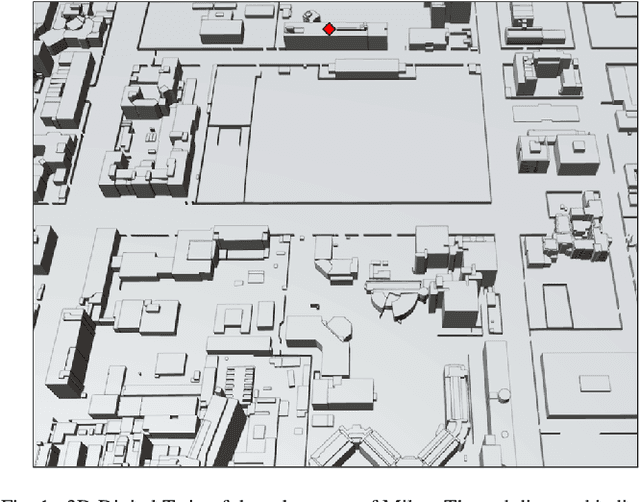
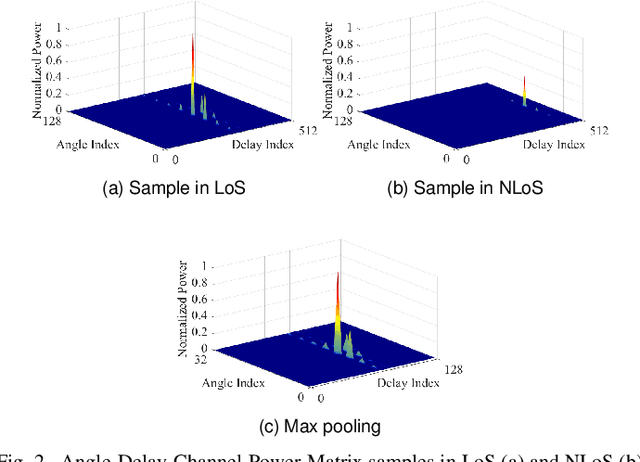
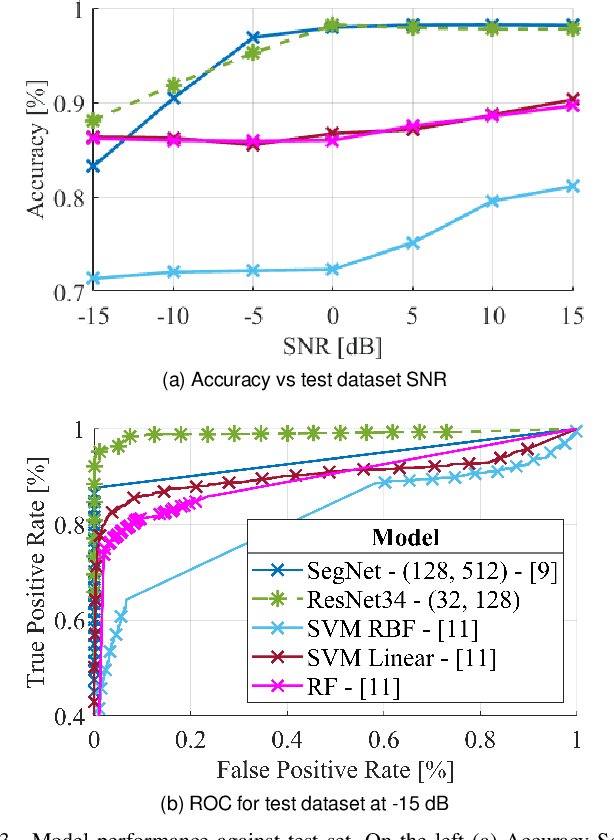
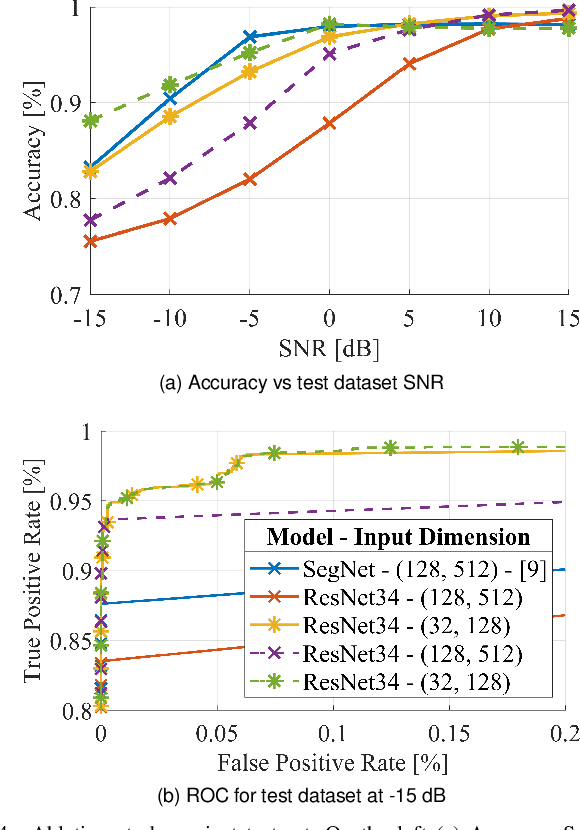
Abstract:The identification of Line-of-Sight (LoS) conditions is critical for ensuring reliable high-frequency communication links, which are particularly vulnerable to blockages and rapid channel variations. Network Digital Twins (NDTs) and Ray-Tracing (RT) techniques can significantly automate the large-scale collection and labeling of channel data, tailored to specific wireless environments. This paper examines the quality of Artificial Intelligence (AI) models trained on data generated by Network Digital Twins. We propose and evaluate training strategies for a general-purpose Deep Learning model, demonstrating superior performance compared to the current state-of-the-art. In terms of classification accuracy, our approach outperforms the state-of-the-art Deep Learning model by 5% in very low SNR conditions and by approximately 10% in medium-to-high SNR scenarios. Additionally, the proposed strategies effectively reduce the input size to the Deep Learning model while preserving its performance. The computational cost, measured in floating-point operations per second (FLOPs) during inference, is reduced by 98.55% relative to state-of-the-art solutions, making it ideal for real-time applications.
Exploiting Age of Information in Network Digital Twins for AI-driven Real-Time Link Blockage Detection
May 21, 2025Abstract:The Line-of-Sight (LoS) identification is crucial to ensure reliable high-frequency communication links, especially those vulnerable to blockages. Network Digital Twins and Artificial Intelligence are key technologies enabling blockage detection (LoS identification) for high-frequency wireless systems, e.g., 6>GHz. In this work, we enhance Network Digital Twins by incorporating Age of Information (AoI) metrics, a quantification of status update freshness, enabling reliable real-time blockage detection (LoS identification) in dynamic wireless environments. By integrating raytracing techniques, we automate large-scale collection and labeling of channel data, specifically tailored to the evolving conditions of the environment. The introduced AoI is integrated with the loss function to prioritize more recent information to fine-tune deep learning models in case of performance degradation (model drift). The effectiveness of the proposed solution is demonstrated in realistic urban simulations, highlighting the trade-off between input resolution, computational cost, and model performance. A resolution reduction of 4x8 from an original channel sample size of (32, 1024) along the angle and subcarrier dimension results in a computational speedup of 32 times. The proposed fine-tuning successfully mitigates performance degradation while requiring only 1% of the available data samples, enabling automated and fast mitigation of model drifts.
Bridging the Gap via Data-Aided Sensing: Can Bistatic ISAC Converge to Genie Performance?
May 02, 2025Abstract:We investigate data-aided iterative sensing in bistatic OFDM ISAC systems, focusing on scenarios with co-located sensing and communication receivers. To enhance target detection beyond pilot-only sensing methods, we propose a multi-stage bistatic OFDM receiver, performing iterative sensing and data demodulation to progressively refine ISAC channel and data estimates. Simulation results demonstrate that the proposed data-aided scheme significantly outperforms pilot-only benchmarks, particularly in multi-target scenarios, substantially narrowing the performance gap compared to a genie-aided system with perfect data knowledge. Moreover, the proposed approach considerably expands the bistatic ISAC trade-off region, closely approaching the probability of detection-achievable rate boundary established by its genie-aided counterpart.
Joint Optimization of Uplink and Downlink Power in Full-Duplex Integrated Access and Backhaul
Apr 05, 2025Abstract:We examine the performance of an Integrated Access and Backhaul (IAB) node as a range extender for beyond-5G networks, focusing on the significant challenges of effective power allocation and beamforming strategies, which are vital for maximizing users' spectral efficiency (SE). We present both max-sum SE and max-min fairness power allocation strategies, to assess their effects on system performance. The results underscore the necessity of power optimization, particularly as the number of users served by the IAB node increases, demonstrating how efficient power allocation enhances service quality in high-load scenarios. The results also show that the typical line-of-sight link between the IAB donor and the IAB node has rank one, posing a limitation on the effective SEs that the IAB node can support.
Optimized Waveform Design for OFDM-based ISAC Systems Under Limited Resource Occupancy
Jun 27, 2024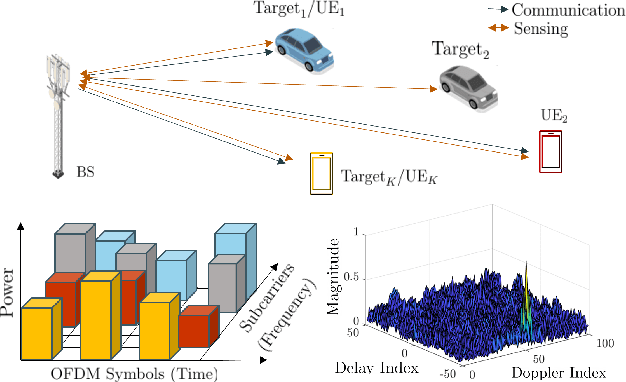
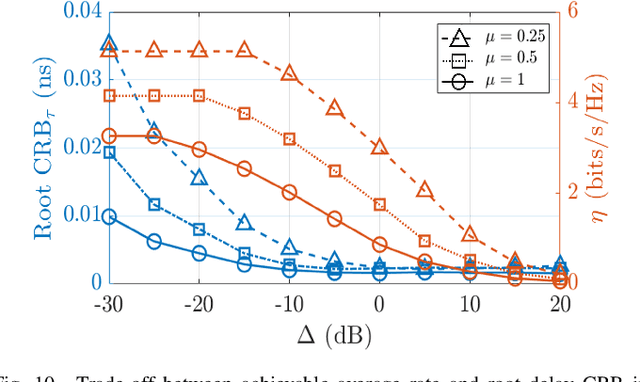
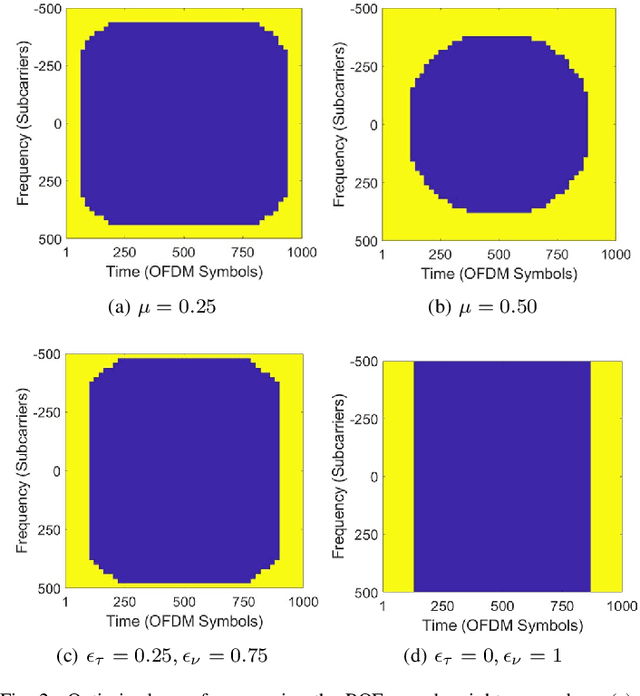
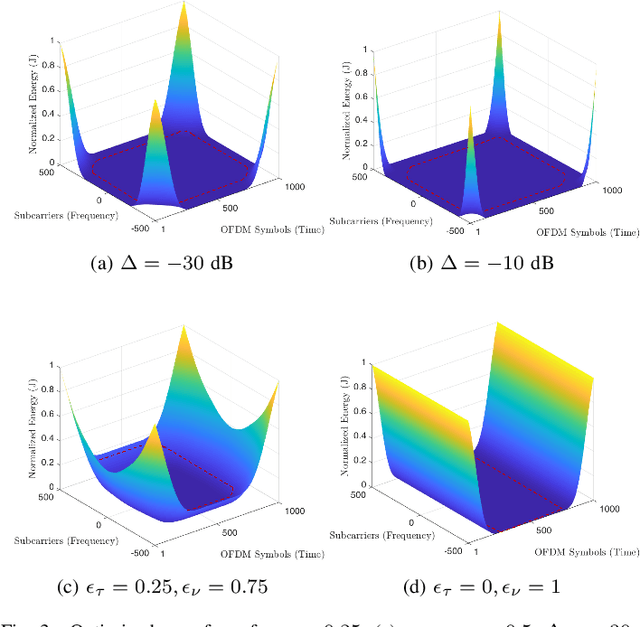
Abstract:The sixth generation (6G) of wireless networks introduces integrated sensing and communication (ISAC), a technology in which communication and sensing functionalities are inextricably linked, sharing resources across time, frequency, space, and energy. Despite its popularity in communication, the orthogonal frequency division multiplexing (OFDM) waveform, while advantageous for communication, has limitations in sensing performance within an ISAC network. This paper delves into OFDM waveform design through optimal resource allocation over time, frequency, and energy, maximizing sensing performance while preserving communication quality. During quasi-normal operation, the Base Station (BS) does not utilize all available time-frequency resources, resulting in high sidelobes in the OFDM waveform's ambiguity function, as well as decreased sensing accuracy. To address these latter issues, the paper proposes a novel interpolation technique using matrix completion through the Schatten p quasi-normal approximation, which requires fewer samples than the traditional nuclear norm for effective matrix completion and interpolation. This approach effectively suppresses the sidelobes, enhancing the sensing performance. Numerical simulations confirm that the proposed method outperforms state-of-the-art frameworks, such as standard complaint resource scheduling and interpolation, particularly in scenarios with limited resource occupancy.
Optimizing Curved EM Skins for Opportunistic Relaying in Vehicular Networks
May 15, 2024



Abstract:Electromagnetic skins (EMSs) are recognized for enhancing communication performance, spanning from coverage to capacity. While much of the scientific literature focuses on reconfigurable intelligent surfaces that dynamically adjust phase configurations over time, this study takes a different approach by considering low-cost static passive curved EMS (CEMS)s. These are pre-configured during manufacturing to conform to the shape of irregular surfaces, e.g., car doors, effectively transforming them into anomalous mirrors. This design allows vehicles to serve as opportunistic passive relays, mitigating blockage issues in vehicular networks. This paper delves into a novel design method for the phase profile of CEMS based on coarse a-priori distributions of incident and reflection angles onto the surface, influenced by vehicular traffic patterns. A penalty-based method is employed to optimize both the average spectral efficiency (SE) and average coverage probability, and it is compared against a lower-complexity and physically intuitive modular architecture, utilizing a codebook-based discrete optimization technique. Numerical results demonstrate that properly designed CEMS lead to a remarkable improvements in average SE and coverage probability, namely when the direct path is blocked.
Waveform Design for OFDM-based ISAC Systems Under Resource Occupancy Constraint
Dec 19, 2023



Abstract:Integrated Sensing and Communication (ISAC) is one of the key pillars envisioned for 6G wireless systems. ISAC systems combine communication and sensing functionalities over a single waveform, with full resource sharing. In particular, waveform design for legacy Orthogonal Frequency Division Multiplexing (OFDM) systems consists of a suitable time-frequency resource allocation policy balancing between communication and sensing performance. Over time and/or frequency, having unused resources leads to an ambiguity function with high sidelobes that significantly affect the performance of ISAC for OFDM waveforms. This paper proposes an OFDM-based ISAC waveform design that takes into account communication and resource occupancy constraints. The proposed method minimizes the Cram\'er-Rao Bound (CRB) on delay and Doppler estimation for two closely spaced targets. Moreover, the paper addresses the under-sampling issue by interpolating the estimated sensing channel based on matrix completion via Schatten $p$-norm approximation. Numerical results show that the proposed waveform outperforms the state-of-the-art methods.
Enhanced Channel Estimation in mm-Wave MIMO Systems Leveraging Integrated Communication and Sensing
Sep 26, 2023



Abstract:This paper tackles the challenge of wideband MIMO channel estimation within indoor millimeter-wave scenarios. Our proposed approach exploits the integrated sensing and communication paradigm, where sensing information aids in channel estimation. The key innovation consists of employing both spatial and temporal sensing modes to significantly reduce the number of required training pilots. Moreover, our algorithm addresses and corrects potential mismatches between sensing and communication modes, which can arise from differing sensing and communication propagation paths. Extensive simulations demonstrate that the proposed method requires 4x less pilots compared to the current state-of-the-art, marking a substantial advancement in channel estimation efficiency.
Integrated Sensing and Communication System via Dual-Domain Waveform Superposition
Dec 15, 2022
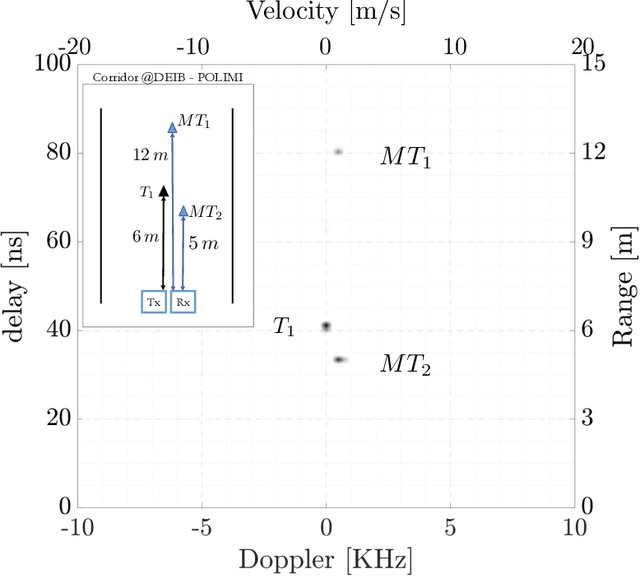
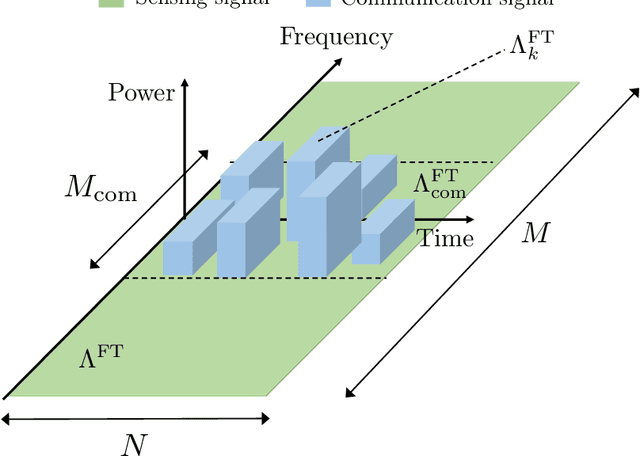
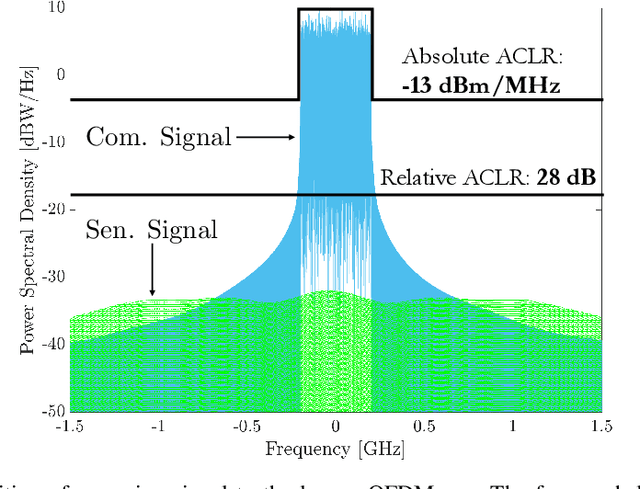
Abstract:Integrated Sensing and Communication (ISAC) systems are recognised as one of the key ingredients of the sixth generation (6G) network. A challenging topic in ISAC is the design of a single waveform combining both communication and sensing functionalities on the same time-frequency-space resources, allowing to tune the performance of both with partial or full hardware sharing. This paper proposes a dual-domain waveform design approach that superposes onto the frequency-time (FT) domain both the legacy orthogonal frequency division multiplexing (OFDM) signal and a sensing one, purposely designed in the delay-Doppler domain. With a proper power downscaling of the sensing signal w.r.t. OFDM, it is possible to exceed regulatory bandwidth limitations proper of legacy multicarrier systems to increase the sensing performance while leaving communication substantially unaffected. Numerical and experimental results prove the effectiveness of the dual-domain waveform, notwithstanding a power abatement of at least 30 dB of the signal used for sensing compared to the one used for communication. The dual-domain ISAC waveform outperforms both OFDM and orthogonal time-frequency-space (OTFS) in terms of Cram\'{e}r-Rao bound on delay estimation (up to 20 dB), thanks to its superior resolution, with a negligible penalty on the achievable rate.
 Add to Chrome
Add to Chrome Add to Firefox
Add to Firefox Add to Edge
Add to Edge